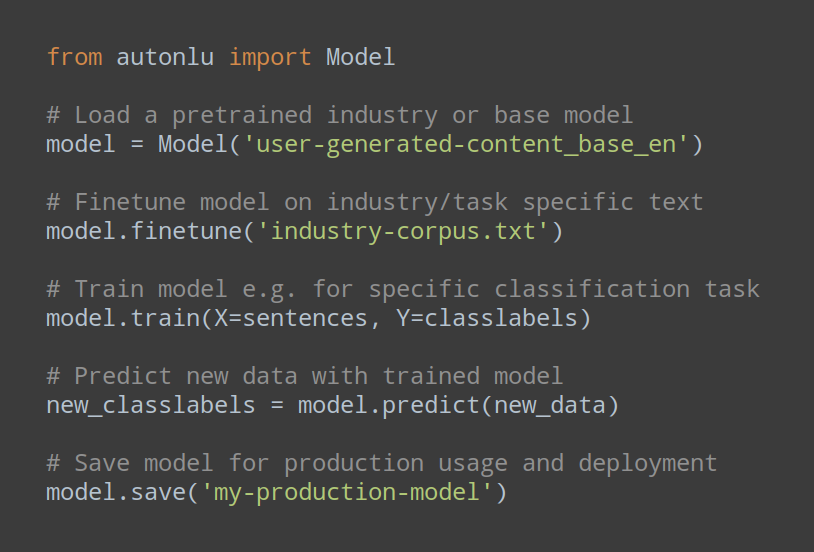Welcome to AutoNLU¶
Automated Natural Language Understanding, powered by state-of-the-art deep learning
If you are interested in using AutoNLU, visit us at https://deepopinion.ai
What is it?¶
AutoNLU is a framework to train and use state-of-the-art Natural Language Understanding (NLU) solutions to solve practical text analysis problems in as few as 5 lines of code:

AutoNLU is currently in beta, but is used by multiple companies in production and has proved to be reliable and stable.
Python versions 3.6, 3.7, and 3.8 on Linux, MacOS, and Windows are supported.
Supported Tasks¶
AutoNLU currently supports three different text classification tasks and two sequence labeling tasks.
text classification
Label task: You want to predict exactly one label for each piece of text. A typical use case would be sentiment analysis where you would like to assign one sentiment to each piece of text.
Class task: You want to predict an arbitrary number of classes (from a given list) for each piece of text. A typical use case would be topic detection, since a text can have none of the possible topics, but it can also have multiple topics.
ClassLabel task: You want to predict one label from a list of possible labels for each of a list of classes. A typical use case would be aspect based sentiment analysis, where we want to predict exactly one sentiment for a number of different aspects.
- sequence labeling
token classification: You like to search a text for some key words e.g. persons, locations, organizations, etc. Such a task is also known as named entity recognition (NER).
question answering: You like to search given text documents for answers to individual questions. Question answering highlights words in a given document that qualify as answer to the posed question.
Core Features¶
Simple API Easy to use API that just works. Designed for developers, engineers and data scientists to achieve the most in a few simple lines of code. As much automation as possible and as flexible as needed.
Always Up-to-Date in NLP NLP is the fastest moving field in AI. With AutoNLU you don’t have to worry about the latest research to get state-of-the-art results - this is on us! You benefit from advances in the field simply by using the latest version of AutoNLU.
Extensively Tested We use our extensive database of industry datasets to test AutoNLU and ensure it produces high-quality results for a broad set of use cases.
Deep Learning First AutoNLU makes state-of-the-art deep learning in NLP accessible for everyone without having to worry about the complexities of dealing with modern deep learning algorithms.
Plug and Play In two lines of code you can instantly use trained task models to predict your data and get results, e.g. by connecting to our Model Library.
Less Data Labeling Reduce the manual data labeling effort by 75% and significantly improve model quality by using the Active Learning feature in AutoNLU.
Interoperability AutoNLU, DeepOpinion Studio and other DeepOpinion products are fully interoperable and models can be easily exchanged between the platforms.
The Power of AutoNLU¶
The following image compares a general tutorial, classifying Google Play Store reviews, using the Huggingface transformers library on the left and the same task solved using AutoNLU on the right.

The AutoNLU solution even provides more functionality than the tutorial code on the left (e.g. automatic early stopping, evaluation of the model in regular intervals during training, logging all results to TensorBoard for easy visualization, no need to set hyperparameters, etc.).
AutoNLU does the right things for you, and just works!
Getting Started
Tutorials
- Predict sentences using the pretrained DeepOpinion ABSA model
- Train a model to label reviews from the GooglePlay store
- Train a model to automatically detect tags of stackoverflow questions
- Train a model to detect opinions on different categories (ABSA) for laptop reviews
- Improve our GooglePlay store example with manual labeling
- Fine-tune your model on unsupervised data to improve the performance
- Increase the speed and reduce the memory consumption by pruning layers of models.
- Reduce inference time by distilling your model
- Perform an Automatic Hyperparameter Search
- Token classification tasks
- Question answering
- Data Cleaning
- Topic modeling - finding topics for a dataset
Known Issues
Changelog